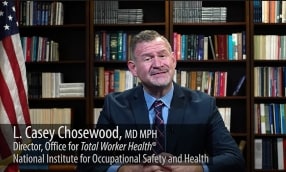Workplace Supported Recovery Program

According to the 2020 National Survey on Drug Use and Health (NSDUH), two-thirds of all adults with an alcohol or illicit drug use disorder have jobs.
Employers should consider creating a Workplace Supported Recovery (WSR) Program to prevent substance misuse, reduce stigma, and encourage recovery. This may include staying at work or returning to work.
WSR programs use evidence-based policies and programs to address multiple risk factors. This approach is consistent with the NIOSH Total Worker Health® Program. Total Worker Health (TWH) strategies integrate all aspects to collectively address worker safety, health, and well-being. Applying TWH approaches to WSR requires building a culture of support for workers, on and off the job.
What is a recovery-supportive workplace?
A recovery-supportive workplace aims to accomplish two things:
- Prevent workplace factors that could cause or prolong a substance use disorder
- Lower barriers to seeking and receiving care, and maintaining recovery
A recovery-supportive workplace teaches managers and workers about substance use disorders to reduce the stigma around this.
Elements of a Workplace Supported Recovery program:

- Prevent work-related injuries and illnesses that could lead to substance misuse
- Reduce difficult working conditions or work demands that might lead to daily or frequent pain
- Promote the use of alternatives to opioids for pain management
- Provide information and access to care for a substance use disorder when required. This includes access to medication-assisted treatment, together with counseling
- Support second-chance employment
- Accommodate workers, as they return to work and offer other return-to-work assistance
- Provide peer support and peer coaching to increase the social support for workers in recovery
- Promote a work culture and climate that is supportive of workers in recovery. For example, build awareness, reduce stigma, and host alcohol-free and health-focused work social events.
What is recovery?
Recovery recognizes substance use disorder as a chronic condition from which individuals can recover. However, it requires access to evidence-based treatments and long-term support. The Office of the Surgeon General defined recovery as “a process of change through which individuals improve their health and wellness, live a self-directed life, and strive to reach their full potential. Even individuals with severe and chronic substance use disorders can, with help, overcome their substance use disorder and regain health and social function. This is called remission. When those positive changes and values become part of a voluntarily adopted lifestyle, that is called ‘being in recovery.’”
Recovery is a voluntary and ongoing process. It may involve cycles of treatment, remission, and recurrence before the person achieves stable recovery. More than just not using substances, recovery is a lifestyle or journey. It is a broad attempt to build or rebuild a healthy, productive, and meaningful life.
Each person’s path to recovery is unique. It is affected by the severity of the substance use disorder and the resources available to the individual. Recovery might include formal treatment (with or without medication-assisted treatment), peer support networks, or a combination. The recovery process has a series of benchmarks:
- early recovery (1 month to 12 months)
- sustained recovery (13 months to 5 years),
- stable recovery (over 5 years).
For those in stable recovery, the risk of a future recurrence in any year drops below 15%, which is about the same annual risk for a substance use disorder in the general population.
Create a Supportive Workplace
Employers and managers can engage in the following activities to help support workers.

Share clear and supportive workplace policies on substance use, including:
- The reasons for the policy.
- The banned substances and behaviors.
- The persons covered by the policy.
- Penalties and appeals.
Provide training to all supervisors and employees.
In-person training is a best practice. Only use online training when in-person training is not feasible. Training should cover:
- Types of drugs (including alcohol)
- The health impacts of misusing them
- How substance use can impact behavior and performance at work
- Workplace policies involving substance use
Evaluate the workplace to reduce working conditions that may lead to employee substance misuse, such as:
- Extra work demands.
- Personal conflict at work.
- Dangerous work.
Workplaces can promote a healthy work environment by designing work that protects workers, such as:
- Fair and equitable treatment.
- Respectful supervision.
- Supportive social connections and friendships among co-workers.
Reduce stigma.
Individuals with or recovering from a substance use disorder experience various levels of stigmatization (negative attitudes and stereotypes). Reducing stigma can help encourage entry into treatment and recovery. To help reduce stigma, put out educational materials and talk about the nature of substance use disorders and recovery. A key talking point is that a substance use disorder is not a moral failing and recovery is possible.
- Provide training to managers and workers to overcome misunderstanding and bias against individuals with substance use disorder.
- Adopt policies in the workplace to raise awareness and support workers and their families struggling with a substance use disorder.
- Eliminate imprecise and pejorative terms from workplace language. Instead, use clinical language that is consistent with terms used for other health conditions. For example, “person with substance use disorder”.
- Ensure that all substance use policies are informed by science and supported by data.
- Learn more about stigma reduction.
Adapted from The Center on Addiction that are parents of adolescents.
Inform employees about relevant resources available through the employer or union.
These resources may be part of a company employee assistance program and health insurance. If an employee assistance program and health insurance are unavailable, provide information on resources in the community.
- Employers should consider evaluating their employee assistance and health insurance programs. Make sure they have personnel trained to deal with substance use problems and have coverage for the following:
- Multiple episodes of treatment (inpatient, outpatient, medication-assisted treatment)
- Long-term follow-up
- Recovery support (such as recovery coaching).
- Peer or co-worker support programs may offer valued and private support. Peer support can include sharing information and providing referrals, advocacy, and accountability. Peers are not usually formally trained to provide clinical services. However, their skills and support may lower barriers to seeking help and following through with treatment.
Have expertise available in employee assistance or health insurance programs to address disparities.
Any worker can engage in substance misuse and develop substance use disorders. However, barriers to treatment and willingness to enter treatment and recovery may vary across populations, based on:
- Religious and cultural norms or expectations
- Family history
- Age
- Education.
Offer health and well-being programs that promote work-life fit and teach functional coping skills.
Programs that promote and support employee well-being may help employees with their recovery efforts by building recovery capital.
Keep employing those with substance use disorders and offer second-chance employment for recovering individuals.
Employment provides economic stability, a meaningful social role, and often direct access to treatment and recovery services. Employment also provides relevant sources of recovery capital that can motivate and maintain a desire for treatment and recovery.
Evaluate workplace norms and drinking rituals that support substance use.
Also, evaluate and reduce current levels of physical availability of substances during the workday.
Physical availability includes:
- The ease of getting alcohol and other drugs at work
- Bringing alcohol or other drugs into the workplace
- Using substances during work hours or breaks.
While after-work drinks can help co-workers unwind and make friends, they can undermine the recovery of co-workers. Recovering co-workers may want to avoid alcohol use but might experience social exclusion at work for not participating.
Focus on the future workforce.
Roughly 90% of individuals with severe substance use disorders began using before the age of 18. Workplaces that employ adolescents and focus on relevant prevention efforts may avoid problems for the next generation of workers. Additionally, a comprehensive WSR program could include resources for employees that are parents of adolescents.

